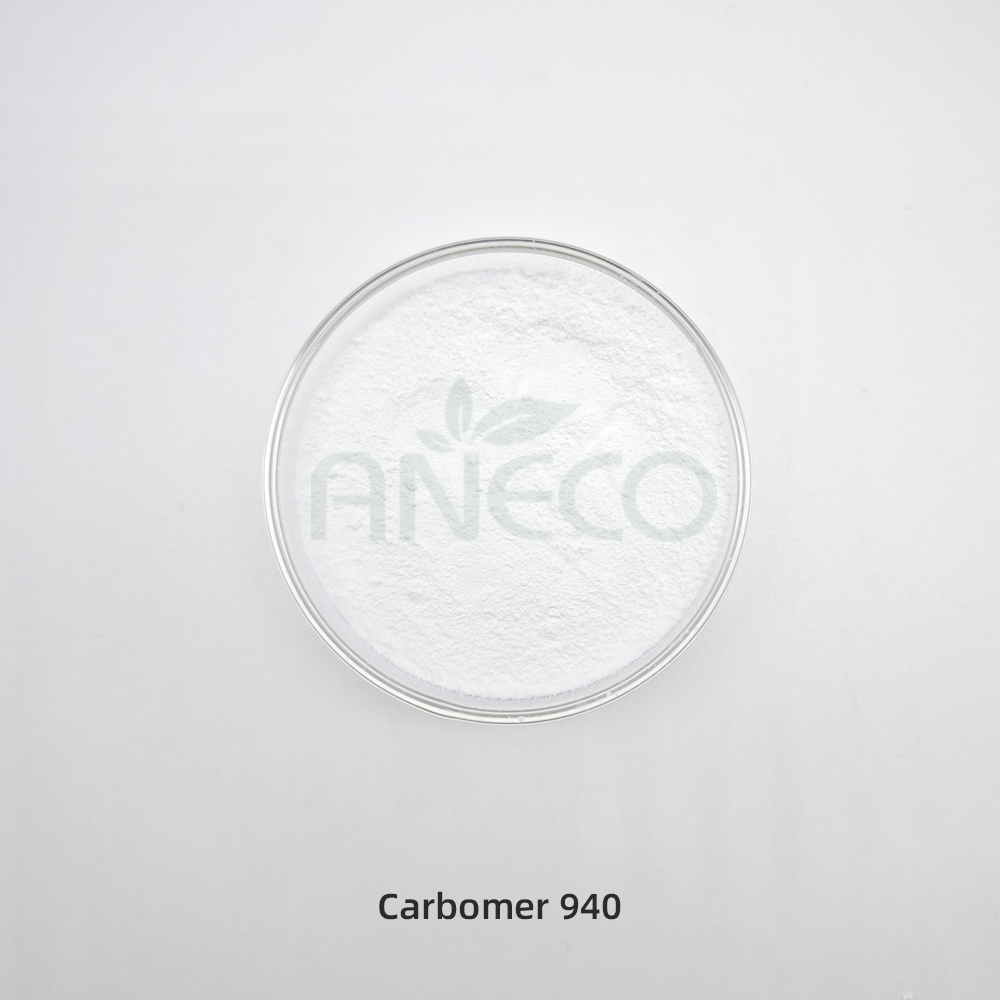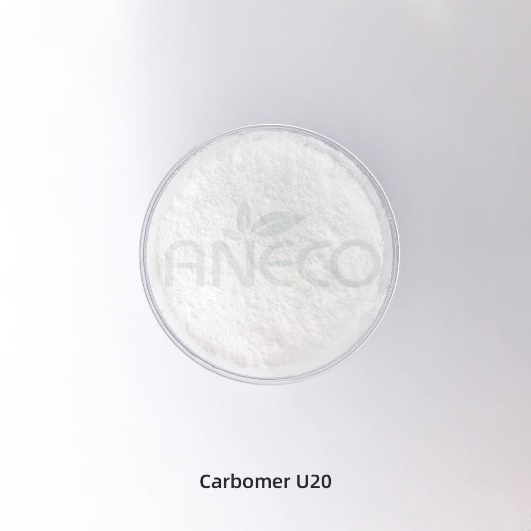





Carbomer Series
Acrylates/C10-30 Alkyl Acrylate Crosspolymer
Carbomer is a polymer formed by the chemical crosslinking of acrylic acid or acrylates with allyl ethers. It includes polyacrylic acid (homopolymer) and long-chain alkyl acrylate polymers (copolymers). Its molecular structure contains 52% to 68% acidic groups, making it inherently acidic. It is also hydrophilic and soluble in water, ethanol, and glycerol.

REQUEST A SAMPLE
BACKGROUND

As the first generation of highly transparent gel matrix, 940 was born in the 1980s when the demand for transparent texture in the high-end skincare market surged. At the time, mainstream thickeners (such as cellulose) were unable to meet the extreme transparency requirements of dressings and serums. By optimising the cross-linking process, 940 became the industry standard for transparent gel products by ensuring thickening efficiency while achieving 90%+ light transmittance.
DESCRIPTION

Carbomer 940 is a highly cross-linked polyacrylic acid polymer renowned for its exceptional thickening efficiency and suspending power. This raw material forms crystal-clear gel systems, making it particularly suitable for high-clarity cosmetic formulations such as transparent serums and gel masks. It delivers optimal performance in the neutral pH range, providing a lightweight, non-sticky texture.
ADVANTAGES

1. High-Efficiency Thickening – Achieves target viscosity at low dosage
2. Superior Clarity – Ideal for premium transparent formulations
3. Short Rheology – Ensures effortless, uniform spreading during application
EFFICACIES

• Stable Thickening – Prevents phase separation and extends product shelf life
• Suspending Capability – Ensures homogeneous dispersion of active ingredients
• Enhanced Spreadability – Promotes even coverage of actives on skin
FAQ

Q1: Which Carbomer is optimal for hyaluronic acid serums?
A1: Carbomer 940 is recommended because:
• It perfectly showcases the crystalline clarity of HA serums
• Forms a gel film enabling sustained release of actives
• Its lightweight, non-tacky texture aligns with serum product requirements
Q2: What are the main differences between various Carbomer grades?
A2: Differences between Carbomer grades primarily lie in their rheological behavior, viscosity, clarity, and ionic tolerance, which also impact skin feel. For example:
940: Short rheology, high viscosity, high clarity, low ionic tolerance;
980: Short rheology, high viscosity, high clarity, moderate ionic tolerance;
U20: Long rheology, medium viscosity, high clarity, high ionic tolerance;
U21: Short rheology, low viscosity, high clarity.
Q3: What are the usage methods and precautions for Carbomer?
A3:
Usage Methods:
Overnight Hydration Method: Disperse Carbomer into deionized water and allow it to hydrate overnight before neutralizing. Avoid stirring during hydration to prevent the formation of lumps.
High-Speed Dispersion Method: Requires vacuum deaeration to avoid microgel residues.
Precautions:
Avoid dispersing in saline or ion-containing water, as this causes a drastic viscosity drop.
Avoid stirring during dispersion and hydration to prevent the formation of "fish eyes".
BACKGROUND

In the early 2000s, when sunscreen regulations were upgraded, it became difficult for traditional thickeners to stabilise the suspension of highly concentrated physical sunscreens (titanium dioxide/zinc oxide). 980 became a core ingredient in physical sunscreen formulations by using acrylic copolymerisation technology to improve suspension while maintaining transparency, and its shear-thinning properties precisely matched the needs of sunscreen product application.
DESCRIPTION

Carbomer 980 is a rheologically optimized acrylic polymer delivering exceptional suspension stability and shear-thinning properties. This raw material is specifically engineered for cosmetic systems requiring stable dispersion of solid particles, such as sunscreens and BB creams. It provides smooth application characteristics and long-term formulation stability, meeting the specialized demands of color cosmetics and UV protection products.
ADVANTAGES

1. Superior Suspension Stability – Ensures homogeneous distribution of active ingredients
2. Short Rheology – Delivers smooth, effortless spreadability
3. Broad pH Compatibility – Adapts to diverse formulation systems
EFFICACIES

• System Stabilization – Maintains consistent performance throughout product shelf life
• Enhanced Sensory Profile – Reduces tackiness for improved user comfort
• Uniform Film Formation – Optimizes efficacy of active ingredients
FAQ

Q1: Why is Carbomer 980 recommended for sunscreen formulations?
A1: Recommended for:
• Exceptional particle suspension capability
• Shear-thinning behavior enabling smooth application
Q2: What are the main differences between various Carbomer grades?
A2: Differences between Carbomer grades primarily lie in their rheological behavior, viscosity, clarity, and ionic tolerance, which also impact skin feel. For example:
940: Short rheology, high viscosity, high clarity, low ionic tolerance;
980: Short rheology, high viscosity, high clarity, moderate ionic tolerance;
U20: Long rheology, medium viscosity, high clarity, high ionic tolerance;
U21: Short rheology, low viscosity, high clarity.
Q3: What are the usage methods and precautions for Carbomer?
A3:
Usage Methods:
Overnight Hydration Method: Disperse Carbomer into deionized water and allow it to hydrate overnight before neutralizing. Avoid stirring during hydration to prevent the formation of lumps.
High-Speed Dispersion Method: Requires vacuum deaeration to avoid microgel residues.
Precautions:
Avoid dispersing in saline or ion-containing water, as this causes a drastic viscosity drop.
Avoid stirring during dispersion and hydration to prevent the formation of "fish eyes".
BACKGROUND

In response to the cosmetic mass production pain point (traditional carbomer dissolution takes 1-2 hours), U20, launched in 2010, uses surface hydrophobic modification technology. Through molecular linkage branching alkyl groups, it achieves rapid dispersion in cold water (reduced to 20 minutes) and significantly improves tolerance to surfactants/electrolytes, making it a revolutionary solution for mass production of toiletries.
DESCRIPTION

Carbomer U20 is a hydrophobically modified acrylic polymer with significantly enhanced dispersion efficiency and electrolyte tolerance through molecular structure optimization. This material features rapid cold-water dispersion properties, making it ideal for electrolyte-containing systems (e.g., shampoos, body washes) and high-throughput cosmetic manufacturing (e.g., lotions, creams). It delivers consistent thickening performance and excellent formulation compatibility.
ADVANTAGES

1. Exceptional Electrolyte Tolerance – Adapts to complex formulations
2. Long Rheology – Exhibits unique flow characteristics during application for distinctive sensory experience
3. Effective Stabilization – Maintains emulsion/suspension stability even at low viscosities
EFFICACIES

• Enhanced Formulation Compatibility – Enables synergistic effects of multiple actives
• Improved Safety Profile – Gentle on all skin types
• Optimized Batch Consistency – Ensures uniform product quality across production runs
FAQ

Q1: What improvements does U20 offer over conventional carbomers?
A1: Key advancements include:
• Rapid cold-water dispersion (vs. special processes required for traditional carbomers)
• Tolerance to common surfactant systems
• Significantly reduced manufacturing cycle time (saving ≥30% processing time)
Q2: What are the main differences between various Carbomer grades?
A2: Differences between Carbomer grades primarily lie in their rheological behavior, viscosity, clarity, and ionic tolerance, which also impact skin feel. For example:
940: Short rheology, high viscosity, high clarity, low ionic tolerance;
980: Short rheology, high viscosity, high clarity, moderate ionic tolerance;
U20: Long rheology, medium viscosity, high clarity, high ionic tolerance;
U21: Short rheology, low viscosity, high clarity.
Q3: What are the usage methods and precautions for Carbomer?
A3:
Usage Methods:
Overnight Hydration Method: Disperse Carbomer into deionized water and allow it to hydrate overnight before neutralizing. Avoid stirring during hydration to prevent the formation of lumps.
High-Speed Dispersion Method: Requires vacuum deaeration to avoid microgel residues.
Precautions:
Avoid dispersing in saline or ion-containing water, as this causes a drastic viscosity drop.
Avoid stirring during dispersion and hydration to prevent the formation of "fish eyes".
BACKGROUND

With the rise of the “ingredient party” (post-2018), highly active/extreme formulations (e.g. acids, algae extracts) face stability challenges.U21 builds on U20 through a nanoscale purification process and crosslinking density optimisation:
- A further 50% increase in dissolution speed
- A 3-fold increase in salt concentration tolerance
- Expanded pH tolerance range to 5-10
- Meet the demanding needs of efficacious skincare products.
DESCRIPTION

Carbomer U21 is a high-performance polymer further optimized from U20 technology, delivering superior wetting speed and system stability. Its meet formulation demands for premium skincare products (e.g., ampoule serums, active treatment emulsions), maintaining stable rheological properties in complex systems containing high concentrations of actives. This makes it ideal for rigorous cosmetic development requiring advanced raw material performance.
ADVANTAGES

1. Ultra-Rapid Wetting – Significantly reduces processing time
2. Suitable for complex formulation requirements
3. Short Rheology – Provides smooth application with immediate skin adherence
EFFICACIES

• Active Ingredient Protection – Maintains efficacy stability throughout product lifespan
• Enhanced System Robustness – Accommodates diverse complex formulations
• Universal Formulation Adaptability – Meets multi-skin type and efficacy requirements
FAQ

Q1: What are the suitable application scenarios for Carbomer U21?
A1: Carbomer U21 is applicable to personal and home care products requiring moderate transparency and tolerance to ionic components, such as surfactant-containing shampoos and body washes (capable of thickening and suspending particles), as well as alcohol-based sanitizing gels. It is also suitable for hair care applications, including conditioners and hair colorants.
Q2: What are the main differences between various Carbomer grades?
A2: Differences between Carbomer grades primarily lie in their rheological behavior, viscosity, clarity, and ionic tolerance, which also impact skin feel. For example:
940: Short rheology, high viscosity, high clarity, low ionic tolerance;
980: Short rheology, high viscosity, high clarity, moderate ionic tolerance;
U20: Long rheology, medium viscosity, high clarity, high ionic tolerance;
U21: Short rheology, low viscosity, high clarity.
Q3: What are the usage methods and precautions for Carbomer?
A3:
Usage Methods:
Overnight Hydration Method: Disperse Carbomer into deionized water and allow it to hydrate overnight before neutralizing. Avoid stirring during hydration to prevent the formation of lumps.
High-Speed Dispersion Method: Requires vacuum deaeration to avoid microgel residues.
Precautions:
Avoid dispersing in saline or ion-containing water, as this causes a drastic viscosity drop.
Avoid stirring during dispersion and hydration to prevent the formation of "fish eyes".


